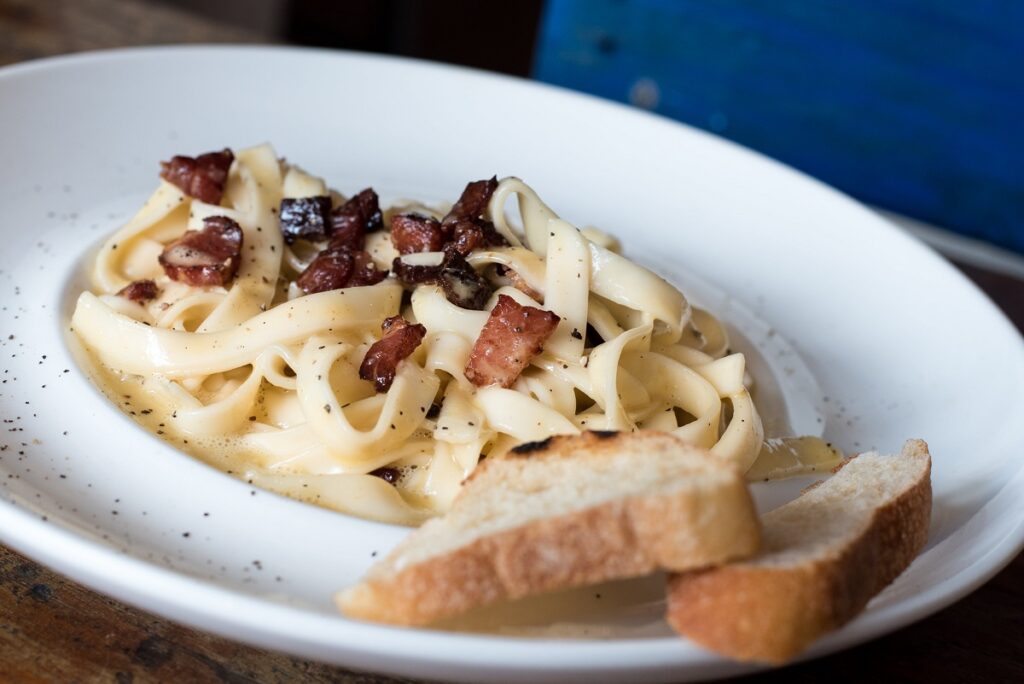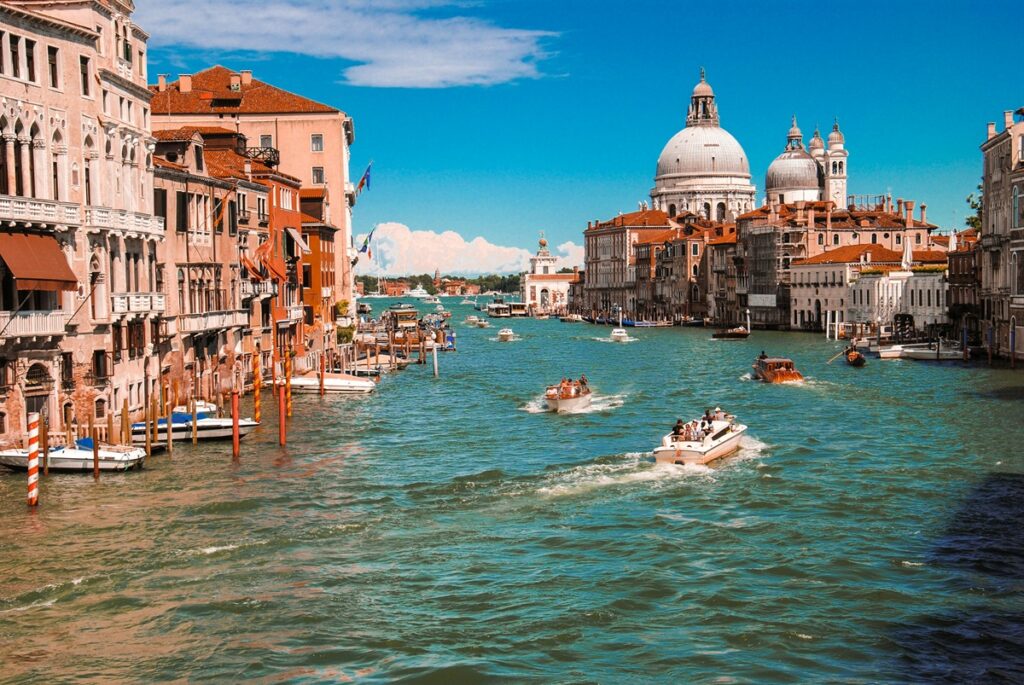Rome, the eternal city, is not just a place of history and art but also a food lover’s paradise. The culinary scene in Rome is a celebration of traditional flavors and a deep connection to the city’s cultural heritage.
If you’re planning to travel to Italy, Rome will probably be your first stop. In this article, we’ll take a delightful journey through Rome’s streets, exploring the diverse and mouthwatering Rome’s food that makes this city a true foodie’s dream.
Table of Contents
- How Good Is Rome’s Food?
- Ancient Rome: Tasting the Flavors of Antiquity
- The Modern Roman Trifecta: Pasta, Pizza, and Gelato
- What Is Street Food In Rome?
- Rome Food Markets
- When In Rome, Do As The Romans Do
How Good Is Rome’s Food?
Rome’s food is fantastic! The city is famous for its delicious pasta, pizza, and a variety of tasty dishes. The chefs in Rome use fresh, high-quality ingredients, making the food flavorful and enjoyable.
Whether you’re trying street food or having a meal in a cozy trattoria, the flavors of Rome are diverse and satisfying. The city offers a range of dining experiences, from casual to fine dining, ensuring there’s something for every taste.
Rome’s food is well-regarded for its rich flavors, traditional recipes, and the unique blend of both classic and modern culinary delights. When dining in Rome be advised – don’t forget to follow the Italian food customs!
Ancient Rome: Tasting the Flavors of Antiquity
In the heart of the ancient world, where marble columns stood tall and gladiators battled in the Colosseum, the people of Rome indulged in a culinary tapestry that reflected their rich history and cultural diversity. Exploring the foods of ancient Rome offers a fascinating glimpse into the culinary practices and flavors that fueled one of the greatest civilizations in history.
The diet of ancient Romans was primarily based on grains, and a significant portion of their daily intake came from a staple called puls. Puls was a simple dish made from a type of porridge or gruel, often made with a mixture of wheat, barley, or spelt. This humble dish served as a dietary cornerstone for both the affluent and the common citizens.
Bread, known as panis, held a crucial place in Roman meals. The variety of bread was vast, ranging from simple white loaves to more intricate offerings with added ingredients like honey, olives, or cheese. Bread was frequently accompanied by olives, cheese, and seasonal fruits to round out a basic Roman meal.
One of the most distinctive features of ancient Roman cuisine was the widespread use of a condiment known as garum. Garum was a fermented fish sauce that added a unique umami flavor to a variety of dishes. Made by fermenting fish, salt, and various herbs, garum was a versatile condiment used by cooks and enjoyed by Romans of all social classes.
As the Roman Empire expanded, so did its culinary horizons. The wealth of the empire allowed for the importation of foreign spices, fruits, and other ingredients from far-flung regions. The Roman elite delighted in indulgent feasts that featured dishes with ingredients like saffron, cinnamon, and even imported flamingo tongues.
No discussion of ancient Roman cuisine would be complete without mentioning the ubiquitous presence of wine. Wine was not only a beverage but also a symbol of status and sophistication. Various varieties of wine, both red and white, were produced across the empire, with some regions gaining renown for their exceptional vintages.

The Modern Roman Trifecta: Pasta, Pizza, and Gelato
Modern Roman cuisine seamlessly blends traditional recipes with contemporary techniques and global influences. Trattorias and restaurants across the city pay homage to classic dishes while introducing creative interpretations that cater to evolving tastes.
Let’s start with the classics – pasta, pizza, and gelato.
Rome’s pasta dishes are all about simplicity and quality ingredients. Let’s take a look at the local favorites that capture the essence of Roman culinary traditions:
Carbonara – spaghetti, crispy guanciale or pancetta (cured pork), eggs, Pecorino Romano cheese, and black pepper.,
Cacio e Pepe – pasta is typically tossed with pasta cooking water, Pecorino Romano cheese and black pepper
Amatriciana – bucatini or spaghetti with white wine, guanciale, tomatoes, Pecorino Romano cheese, and red pepper flakes for a touch of heat.
Pizza in Rome is thin and crispy, a delight for pizza lovers. Classics like Margherita and Marinara showcase local freshness and the skill of Roman pizza makers.
In addition to the classic round pizza, Rome boasts a unique variation known as Pinsa Romana. Dating back to ancient Roman times, the Pinsa features a lighter, airier crust made from a blend of different flours, including rice and soy. This historical twist adds an extra layer of texture and flavor, making the Pinsa a delightful alternative for those seeking a truly authentic Roman pizza experience.
And when it’s time for something sweet, indulge in authentic Italian gelato. Stroll through the streets and discover gelato shops offering traditional flavors like Stracciatella and Pistachio, or try something new like Fig and Honey or Basil.
What Is Street Food In Rome?
Street food in Rome is a delightful and integral part of the city’s culinary culture. The streets of Rome offer a diverse array of portable, flavorful, and often wallet-friendly treats that cater to locals and visitors alike. Here are some popular street food options you can find while strolling through the charming neighborhoods of the Eternal City:
Supplì: A Roman street food staple, supplì are deep-fried rice balls that are crispy on the outside and oozing with melted mozzarella and ragù (meat and tomato sauce) on the inside. They are a popular snack or appetizer, enjoyed for their savory and satisfying taste.
Pizza al Taglio: Translating to “pizza by the cut,” this style of pizza involves baking a large rectangular pizza and cutting it into smaller, rectangular slices. The variety of toppings is extensive, and you can choose your preferred slice, pay by weight, and enjoy it on the go.
Trapizzino: A modern twist on traditional Roman flavors, the trapizzino is a triangular pocket of pizza dough filled with classic Roman dishes like braised oxtail (coda alla vaccinara), chicken cacciatore, or eggplant parmigiana. It’s a handheld delight that combines the best of pizza and traditional Roman fare.
Panini and Sandwiches: Numerous street vendors and small shops in Rome offer a variety of panini and sandwiches. You can find classic combinations such as prosciutto and mozzarella or porchetta (roast pork) with arugula. These handheld delights are perfect for a quick and satisfying meal on the go.
Carciofi alla Giudia: Artichokes prepared “Jewish-style” involve deep-frying whole artichokes until they become crispy and golden brown. This unique and delicious street food is a specialty in the Jewish Ghetto of Rome, offering a savory and flavorful experience.
Porchetta Sandwich: Porchetta, a succulent and flavorful roast pork, is often sliced and served in a crusty roll. The combination of crispy skin and tender meat makes the porchetta sandwich a popular choice among locals and tourists alike.
Gelato: While gelato is not exclusive to Rome, the city boasts numerous gelaterias offering a variety of flavors made with high-quality ingredients. It’s the perfect sweet treat to enjoy while strolling through Rome’s historic streets.
Fried Seafood (Fritto di Mare): Near the Roman markets, especially in areas like Testaccio, you may find vendors selling a variety of fried seafood, including calamari, shrimp, and small fish. This savory and crispy delight is a popular choice for seafood lovers.

Rome Food Markets
Rome is home to vibrant food markets that offer a feast for the senses. These markets are not only places to shop for fresh, local ingredients but also vibrant hubs of culinary culture. Here are some notable food markets in Rome:
- Campo de’ Fiori Market:
- Location: Piazza Campo de’ Fiori
- Open: Monday to Saturday (morning till early afternoon)
- Highlights: A bustling market known for its colorful array of fruits, vegetables, flowers, and spices. You’ll also find local products such as olive oil, balsamic vinegar, and fresh pasta.
- Mercato di Testaccio:
- Location: Via Beniamino Franklin
- Open: Monday to Saturday (morning till early afternoon)
- Highlights: A popular market among locals, Mercato di Testaccio offers a wide range of fresh produce, meats, cheeses, and seafood. It’s an excellent place to experience authentic Roman flavors.
- Mercato Trionfale:
- Location: Via Andrea Doria
- Open: Monday to Saturday (morning till early afternoon)
- Highlights: One of the largest covered markets in Rome, Mercato Trionfale is known for its extensive selection of fresh produce, meats, cheeses, and gourmet products. It’s a great place to explore local specialties.
- Esquilino Market (Mercato Esquilino):
- Location: Via Principe Amedeo
- Open: Monday to Saturday (morning till early afternoon)
- Highlights: Situated in the multicultural Esquilino neighborhood, this market reflects Rome’s diverse population. You’ll find a mix of Italian and international products, including spices, fruits, and a variety of street food.
- Mercato Centrale Roma:
- Location: Termini Station, Via Giovanni Giolitti
- Open: Daily (morning till midnight)
- Highlights: Located inside Termini Station, Mercato Centrale Roma is a modern food market offering a mix of traditional and innovative food stalls. It’s a great spot for a quick bite or to pick up high-quality ingredients.
- Nuovo Mercato di Testaccio:
- Location: Via Galvani
- Open: Tuesday to Sunday (morning till early afternoon)
- Highlights: A more recently renovated version of the Mercato di Testaccio, this market provides a modern and clean environment to explore a variety of fresh produce, meats, and regional specialties.
When In Rome, Do As The Romans Do
In conclusion, Rome’s culinary landscape is a tapestry woven with the threads of tradition, innovation, and a deep love for flavorful ingredients. From the timeless classics like Carbonara and pizza to the modern twists found in gourmet establishments and bustling food markets, the city’s food scene invites both locals and visitors on a delectable journey through the heart of Italian cuisine.
The enchanting aroma of fresh herbs, the sizzle of street food in historic piazzas, and the warmth of trattorias serving home-cooked delights—all contribute to the unique and unforgettable experience of dining in the Eternal City. Rome not only preserves its culinary heritage but also embraces the evolving tastes of a global audience, ensuring that every meal is a celebration of the city’s rich gastronomic legacy.
So, whether you’re savoring a scoop of gelato while wandering the cobbled streets or indulging in a gourmet feast overlooking ancient ruins, Rome’s food is a symphony of flavors that transcends time and captivates the soul. As the saying goes, “When in Rome, eat as the Romans do,” and with every bite, you’ll be taking a delicious journey through history and culture. Buon appetito!




Great post. I was checking constantly this blog and I’m impressed!
Very useful info particularly the last part 🙂 I care for such information a lot.
I was looking for this particular info for a long time. Thank you
and best of luck.
Ahaa, its good dialogue about this paragraph at this place at
this web site, I have read all that, so now me also commenting here.